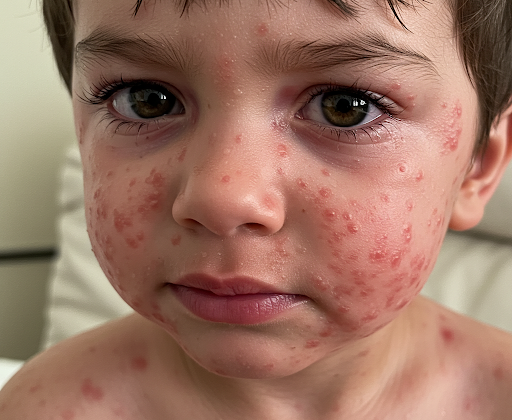In early 2025, the United States has experienced a significant resurgence of measles cases, particularly in Texas and New Mexico. This outbreak has raised public health concerns due to its rapid spread and severe consequences, including the tragic death of an unvaccinated child in West Texas—the first such fatality in over a decade.
The Recent Measles Outbreak: An Overview
Measles, once declared eliminated in the United States in 2000, has re-emerged with alarming frequency in recent years. As of February 2025, the Centers for Disease Control and Prevention (CDC) reported 98 confirmed cases across eight states, with Texas alone accounting for 124 cases—a significant increase from previous weeks. The majority of these cases have been reported in the South Plains region of Texas, particularly between Lubbock and Midland-Odessa, with Gaines County being notably affected. Additionally, nine cases have been confirmed in eastern New Mexico, though these are not linked to the Texas outbreak.
Factors Contributing to the Outbreak
Several factors have contributed to the recent surge in measles cases:
- Low Vaccination Rates: The decline in vaccination coverage has created pockets of susceptible individuals, facilitating the spread of the virus. The CDC notes that MMR (measles, mumps, and rubella) vaccination rates among kindergarteners have fallen below the 95% target, with some communities experiencing even lower coverage.
- Environmental Conditions: The dry climate of West Texas, characterized by low humidity, allows the measles virus to survive longer in the air. Strong winds in the region can further disseminate the virus over greater distances. Moreover, temperatures between 60 and 70 degrees Fahrenheit, typical of late winter and early spring, are conducive to the virus’s persistence.
- Global Travel: Increased international travel has facilitated the importation of measles cases from countries where the virus remains endemic, leading to outbreaks in under-vaccinated U.S. communities.
Understanding Measles: Symptoms and Transmission
Measles is a highly contagious viral infection that primarily affects the respiratory system. The virus spreads through respiratory droplets when an infected person coughs or sneezes. It can remain viable in the air and on surfaces for up to two hours, making transmission possible even without direct contact with an infected individual.
Symptoms of Measles
Symptoms typically appear 7 to 14 days after exposure to the virus and progress through several stages:
- Incubation Period: This asymptomatic phase lasts about 10 to 14 days post-exposure.
- Prodromal (Early) Symptoms: Initial symptoms resemble those of a severe cold or flu and may include:
- High Fever: Often exceeding 104°F (40°C).
- Cough: Persistent and dry.
- Runny Nose: Clear nasal discharge.
- Conjunctivitis: Red, watery eyes.
- Koplik’s Spots: Small white spots with bluish centers on the inner lining of the cheeks, appearing 2 to 3 days before the rash.
- Rash Onset: 3 to 5 days after initial symptoms, a red, blotchy rash emerges, starting at the hairline and progressing downward to the face, neck, trunk, and limbs. The rash often coalesces into larger patches and may be accompanied by a spike in fever.
Potential Complications
While measles is often self-limiting, it can lead to severe complications, especially in young children, pregnant women, and immunocompromised individuals. Common complications include:
- Ear Infections: Occurring in about 1 in 10 children with measles, potentially leading to hearing loss.
- Diarrhea: Affecting approximately 1 in 10 children, which can lead to dehydration.
- Pneumonia: Developing in up to 1 in 20 children, pneumonia is a serious lung infection and a leading cause of measles-related deaths.
- Encephalitis: A rare but severe brain inflammation occurring in about 1 in 1,000 cases, which can result in permanent neurological damage.
- Subacute Sclerosing Panencephalitis (SSPE): A fatal, progressive brain disorder that can develop years after measles infection, though it is exceedingly rare.
Preventing Measles: Staying Safe
Prevention is paramount in controlling the spread of measles. The following measures are essential:
Vaccination
- MMR Vaccine: The measles, mumps, and rubella vaccine is highly effective, with two doses providing approximately 97% immunity against measles. The CDC recommends the first dose at 12 to 15 months of age and the second dose at 4 to 6 years. Unvaccinated individuals, including adults, should consult healthcare providers about receiving the vaccine.
Community Measures
-
Maintaining High Vaccination Coverage: Achieving and sustaining a 95% vaccination rate within communities is crucial to establish herd immunity, protecting those who cannot be vaccinated due to medical reasons.
-
Public Awareness Campaigns: Educating the public about the importance of vaccination and the risks associated with measles can encourage vaccine uptake and dispel misconceptions.
-
School and Workplace Policies: Implementing policies that require up-to-date vaccinations for attendance can reduce the risk of outbreaks in educational and professional settings.
-
Rapid Response to Outbreaks: Health authorities should swiftly identify and isolate.
Conclusion
The recent measles outbreak in Texas and New Mexico underscores the critical importance of maintaining high vaccination rates to prevent the resurgence of this highly contagious disease. Measles can lead to severe complications, especially among unvaccinated populations. The most effective preventive measure is the administration of the MMR vaccine, which provides robust immunity against the virus. Ensuring widespread vaccination coverage not only protects individuals but also fortifies community health by establishing herd immunity. Public health initiatives must continue to focus on educating communities about the benefits of vaccination and implementing policies that support immunization efforts. By collectively prioritizing these measures, we can mitigate the impact of current outbreaks and prevent future occurrences, safeguarding public health for all.












